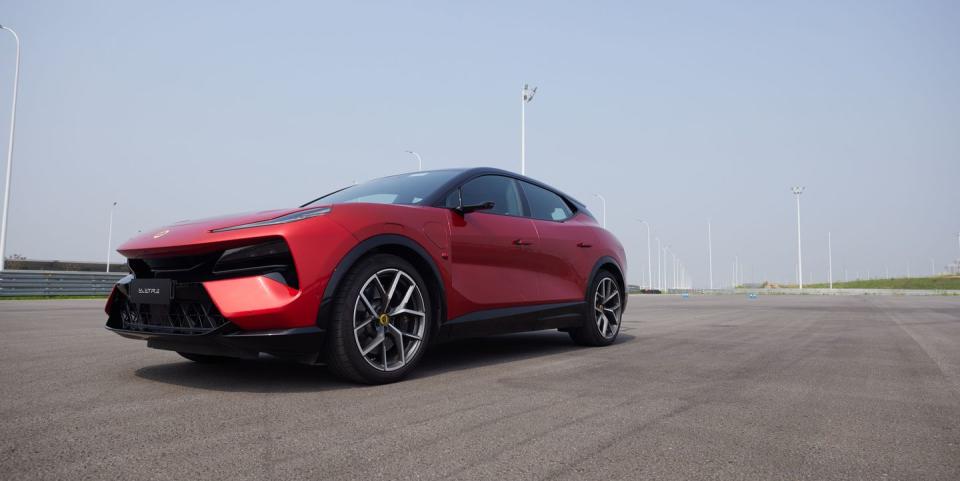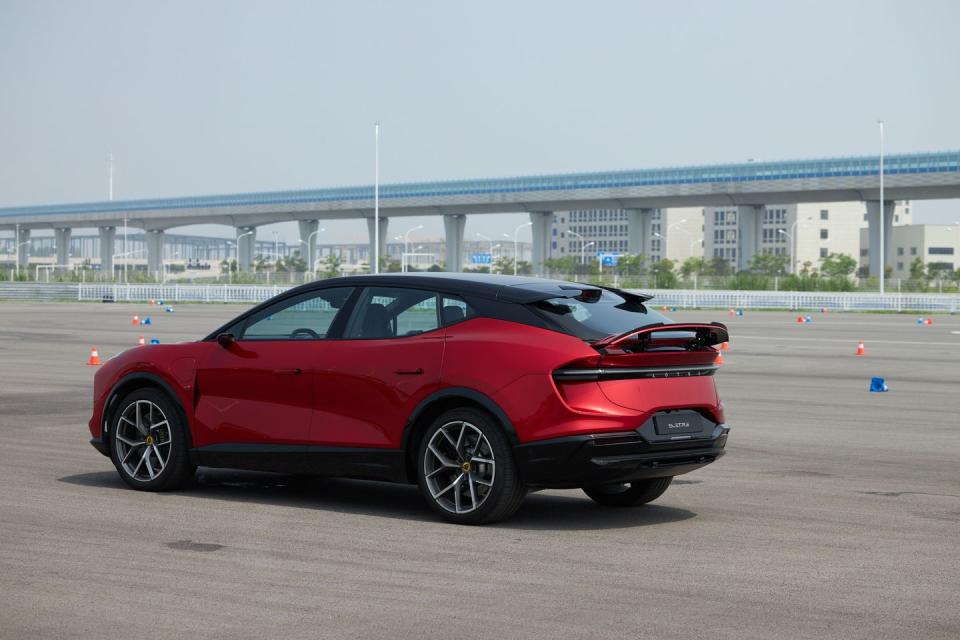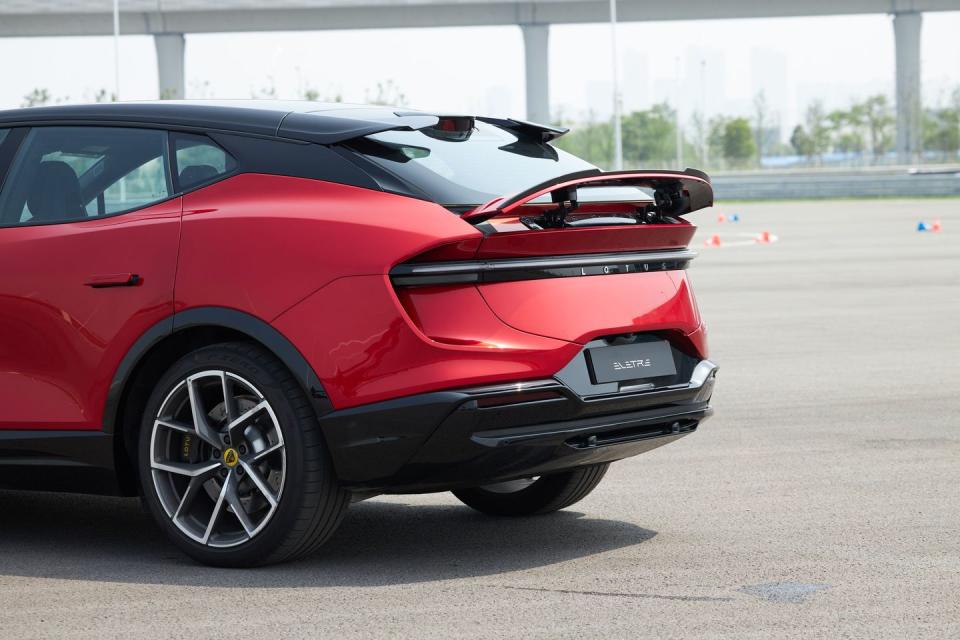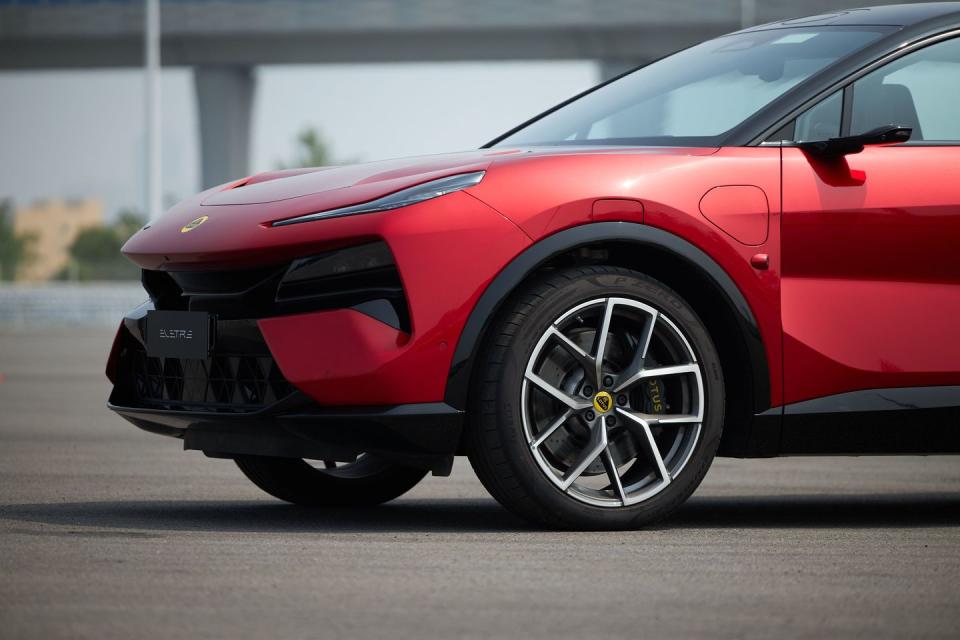Lotus Eletre Prototype EV Swaps Lightness for Space and Blistering Speeds

First drives of pre-production Lotus Eletres in both standard S (twin 301-hp electric motors, one turning each axle, drawing a peak of 602 hp from the 112-kWh 800-volt battery pack) and R (swapping in a brawnier 603-hp rear motor for a system peak of 905 hp) trims reveal blistering straight-line speeds and chronically understeering handling.
The Eletre and the two sister EVs will share a platform whose combined output could reach 150,000 units per year, unprecedented volumes for Lotus.
Lotus says the Eletre will support higher-level autonomy, too, with LIDAR sensors able to offer Level 3 support (in markets that allow it) soon after the car is launched.
Lotus founder Colin Chapman’s engineering philosophy was summed up by his famous line “simplify, then add lightness.” Which hasn’t happened here. The Eletre is the most radical Lotus since, well, forever—packed with innovation and technology, including the promise that it will be one of the pioneers of higher level autonomy. But although the final weight is yet to be officially confirmed, it also weighs 5300 lbs. Which, to save you from the need to look it up, is about four times as much as the Series 1 Elan from 1969, and nearly three times the mass of the 1996 Elise.
Are these necessarily bad things? Lotus has lurched between existential crises for most of its 75 years of history, including several while Chapman—who died in 1982—was still alive. The company has also perpetually been a niche player, having produced fewer than 125,000 cars since its foundation. The Eletre and the two sister models that will share its platform are going to be produced in unprecedented volumes for Lotus; as soon as 2028 the plan is to be making 150,000 every year at the brand new plant in Wuhan, China. If the EVs become a success they may even overwrite the city’s more notorious claim to fame.

Autoweek traveled to China to drive late pre-production versions of the Eletre. These didn’t wear disguise—as we weren’t allowed to leave the confines of the two-mile test track built alongside the factory—but they were not fully finished cars, with engineers still working on finalizing the chassis settings for European-spec cars that will go on sale later this year. In the States we’ll have to wait until 2024 for the Eletre.
Geely, which owns Lotus, is already one of the leading EV makers in China, where buyers bought more than six million EVs and PHEVs last year. But the Eletre is going to be positioned above any of the Group’s other EV products, including those made by Volvo and Polestar. Two powertrains will be offered for the Lotus, both with all-wheel drive through two motors. The standard Eletre and the Eletre S t will use twin 301-hp electric motors, one turning each axle, drawing a peak of 602 hp from the 112-kWh 800-volt battery pack. The range-topping Eletre R will swap the standard rear e-motor for a brawnier 603-hp one which drives through a two-speed gearbox, giving a system peak of 905 hp. That’s nearly as much as the Tesla Model S Plaid. I got to experience both outputs in the Eletre S and the Eletre R.
The basics are certainly impressive. In the metal the Eletre radiates presence. As we reported before, exterior dimensions are very close to those of the Lamborghini Urus, as the design has a certain similarity, too. Beyond badging it would be hard to nominate anything about the Eletre’s exterior that bears any obvious Lotus DNA or relationship to earlier models. It is on a different scale, too—although as we previously commented, its 201-inch length, 64.2-inch height, and 118.9-inch wheelbase are all less than an inch different from the Lamborghini SUV.
The interior is just as radical; this is certainly the first Lotus to offer a seat massage function. The Eletre will only come with two rows, but with the choice of a rear bench or individual chairs offering either four- or five-seat configurations. It is spacious front and rear in either guise, although visibility in the back is limited by the rising glassline.
Up front the driver gets a squared-off steering wheel with the dashboard featuring three digital displays—driving information ahead of the driver, a huge 15.1-inch OLED touchscreen in the center and then another letterbox display in front of the passenger which can give different types of information. It’s the same layout that’s been seen in recent Ferraris. Materials are classy and the standard of fit and finish of all the cars in Wuhan felt high.
I start off in the Eletre S. The Eletre doesn’t have an ignition key or any start-stop button; when a keycard is detected in the cabin it is ready to go and Drive or Reverse can be selected. Throttle response is delay-free and proportional, and even in its gentlest Tour dynamic mode the Eletre S feels impressively potent: launching hard enough to chirp its P-Zero tires and—on the track’s 1100-yard main straight—accelerating beyond the point where most EVs start to hit the treacle; Lotus claims that even the less powerful Eletre has a 160-mph top speed. It also has a synthesised soundtrack which gives a sense of speed and throttle position without becoming overbearing.

Standard air suspension and adaptive dampers allow the Eletre’s base suspension settings to be soft, with that evident in the way the hood lifts and dips under hard acceleration and braking. Selecting the firmer Sport mode reduced this, without introducing any apparent harshness. The cars in China were all fitted with the 48-volt active antiroll system, which uses motors to apply torque to the sway bars to counter lean, and this worked well on the test track’s many tight corners.
Less convincing was the steering. This does allow discernible feedback to pass to a driver’s fingers, but working with the active rear steering system that tries to tip the car into slower turns it also denies the Eletre the linear responses that have always been one of Lotus’s dynamic benchmarks.
In this, it needed plenty of help. Regardless of dynamic mode, the Eletre S suffered from understeer on the test track’s many tight corners—also its less tight ones—the front end pushing wide whenever power was applied. The combination of the punishing track layout, which is normally driven at lower speeds, plus 95-degree temperatures was causing the tires to overheat and pressures to spike. Smart systems might be able to disguise some of the laws of physics, but they can’t magic them away.
Switching to the Eletre R gave the chance to go even quicker. The more powerful car feels equally civilized when driven at a gentle place, chassis settings equally plush in its Tour and Sport modes. But straight-line performance is in a different league, the R capable of generating the sort of g-forces that shuffle the positions of internal organs. Lotus claims a 2.9-second 0-62 mph time, which feels entirely feasible after a stamped-throttle launch.
More impressive is the rate at which acceleration continues to build as speeds rise. With the director of the Lotus factory, Xi Tan, riding shotgun, I get to experience full throttle down almost the entire length of the main straight, the Eletre R’s digital speedometer showing 240 km/h—that’s 149 mph—by the far end. Fortunately the brakes are excellent, the standard iron discs hauling off the momentum and absorbing big thermal loads without complaint; buyers will also be able to choose from optional carbon-ceramics. The brake pedal feels firm and natural, blending friction and regenerative retardation invisibly.
The Eletre R also has an additional dynamic mode, Track, however unlikely it might be that many buyers are choosing an electric SUV for regular circuit work. Riding on cooler tires, the R generated much less understeer than the S had done, also making it easier to neutralize much of the remaining push by playing with the car’s balance. The R feels very stable, but not especially playful—the rear axle uses an open differential with torque biasing by applying the brake on one side rather than using an active diff. Unlike EVs including the Kia EV6 GT and Hyundai Ioniq 5 N it doesn’t feature an oversteer-happy drift mode.

Other elements were barely experienced in Wuhan. The Eletre is going to support higher-level autonomy, with LIDAR sensors that deploy from the front fenders when the system is active, Lotus promising it will be able to offer Level 3 support (in markets that allow it) soon after the car is launched. Nor did I get the chance to test the claims for peak charging speed, with Lotus saying the 420kW DC charging peak will enable the 113kWh pack to add up to 248 miles of range in just 20 minutes. The other unanswered question is what the “standard” steering feels like, with Lotus planning to offer lower spec versions without the variable ratio rack and rear steering. More natural, I suspect.
The Eletre is a different sort of Lotus, aimed at a different market. On first impressions it feels further away from the company’s previous models than the first Cayenne did Porsche’s at the time it was launched. Comparing the Eletre to the brand’s sports cars will always find it wanting in terms of the virtues that come from lightness and simplicity. Conversely, no other Lotus has ever been able to accommodate four or five occupants in such space and comfort, or to be able to drive themselves. Give it a few years and Lotus may well be better known for the latter set of values than the more traditional ones.

 Yahoo Autos
Yahoo Autos 